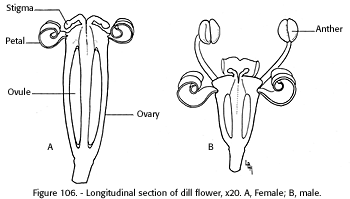DILL
Anethum graveolens L., family UmbelliferaeDill is grown primarily for its seeds and herbage used in seasoning of foods. The best known food product is dill pickles. According to Hawthorn and Pollard (1954*), only about 100 acres is devoted to the production of dill seed in the United States. Martin and Leonard (1949*) stated that 500 to 700 pounds of seed are produced per acre, yielding 20 pounds oil. Production is limited to the north central United States and the Pacific northwest (Rosengarten 1969*).
Plant:
Dill is a glabrous annual or biennial herb, 2 to 4 feet tall, usually grown in rows 30 inches apart, with the plants 6 inches apart in the row (fig. 105).
[gfx] FIGURE 105. - Branch of dill, showing typical arrangement of florets and seed.
Inflorescence:
Unlike the flowers of most other umbelliferous crops, the small yellow dill flowers contain little nectar, although they have a strong odor. They are visited by many insects, chiefly flies and bees. Knuth (1908*, p. 462) stated that the flowers are homogamous and hermaphroditeÑthe primary umbels bearing hermaphrodite flowers, the secondary and tertiary ones bearing hermaphrodite ones on the margins and staminate ones in the center, similar to coriander. On the plant from which the flower illustrated in figure 106 was taken, some of the flowers were entirely pistillate (female), some staminate (male), and a few were hermaphrodite.
The ovary of the 5-mm pistillate flower normally contains two ovules, although in numerous pistillate flowers examined, one or both had aborted. Nectar is visible on staminate flowers, but there is little or none in pistillate flowers. The 2-mm yellow staminate flower has five stamens that are about 1 mm long when extended and dehiscing pollen. The strongly incurved petals never completely straighten out. The stamens arise between the petals.
[gfx] FIGURE 106. - Longitudinal section of dill flower, x 20. A, female; B, male.

Pollination Requirements:
Flemion and Waterbury (1941) and Flemion and Uhlmann (1946) found an average of 16 percent of the seed embryoless or with immature embryos in the Umbelliferae, including dill. No correlation was found between embryolessness and plant spacing, seed size, yield, temperature, rainfall, fertilizers, or seed from different areas. However, when Flemion and Henrickson (1949) confined nine dill plants in insect-free cages during the flowering period, only 59 seeds per primary unbel were obtained, but when nine plants were caged with houseflies present, 1,001 seeds per primary umber were obtained, showing that insect pollination is essential to good seed set.
Pollinators:
Both flies and bees have been mentioned as pollinators of dill. If seed is grown commercially, there are probably not enough flies in the vicinity to pollinate all the flowers. Honey bees can be moved to the field, and doubtless this should be done if the highest seed production is desired.
Pollination Recommendations and Practices:
None. If maximum seed production is desired the meager evidence indicates that a heavy population of honey bees should be created in the field.
LITERATURE CITED:
FLEMION, F., and HENRICKSON, E. T.
1949. FURTHER STUDIES ON THE OCCURRENCE OF EMBRYOLESS SEEDS AND IMMATURE EMBRYOS IN THE UMBELLIFERAE. Boyce Thompson Inst. Contrib. 15(6): 291 - 297.____ and UHLMANN, G.
1946. FURTHER STUDIES OF EMBRYOLESS SEEDS IN UMBELLIFERAE. Boyce Thompson Inst. Contrib. 14(4): 283 - 293.____ and WATERBURY, E.
1941. EMBRYOLESS DILL SEED. Boyce Thompson Inst. Contrib. 12: 157 - 161.
